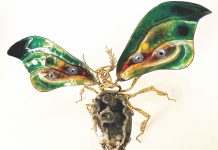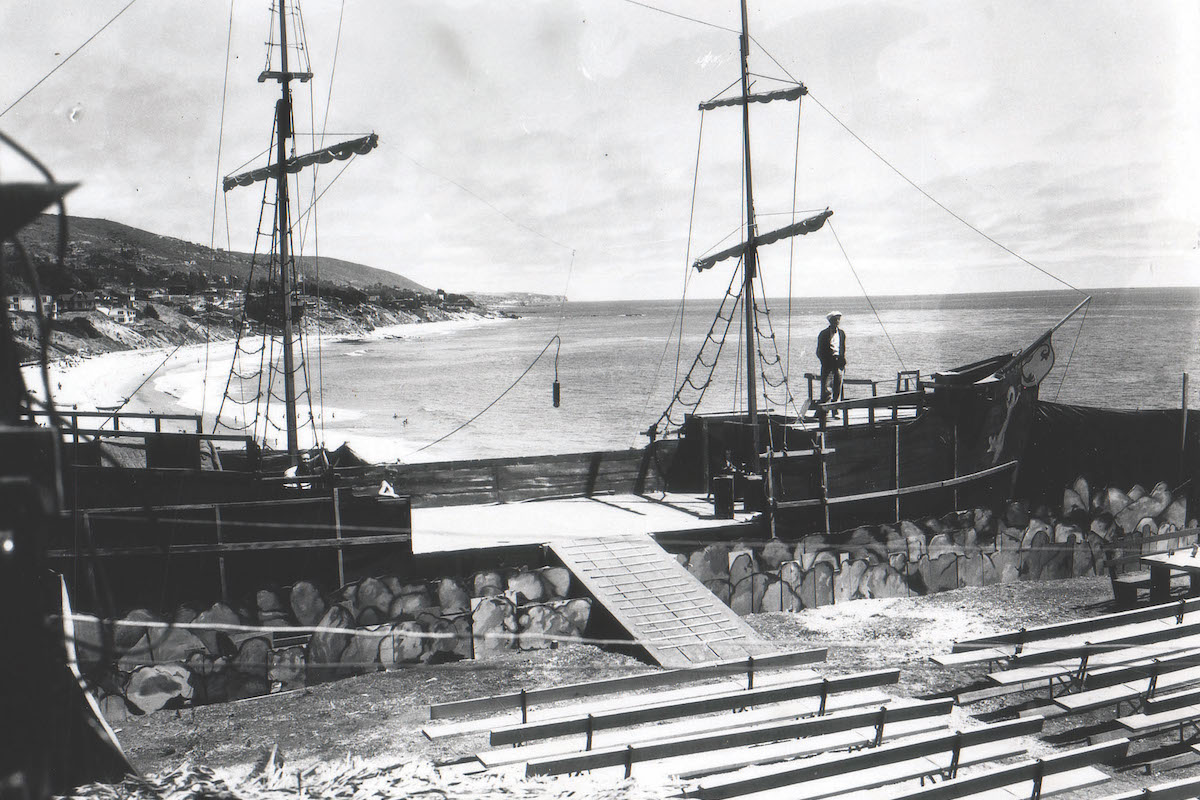
Pageant of the Masters shares historic photos and memories to celebrate the iconic show’s 90th anniversary.
By Sharon Stello
In honor of the 90th anniversary of Pageant of the Masters—the beloved “tableaux vivants,” or living pictures show that’s presented each summer at Festival of Arts—organizers have cracked open the vault to share archived photos and stories from years gone by. Here are just a few of the gems from the past to enjoy leading up to this summer’s rendition, which runs from July 7 to Sept. 1 with the theme “Art Colony: In the Company of Artists.”
In nine decades, the Pageant has only missed five years of shows—from 1942 to 1945, due to World War II, and in 2020, due to the COVID-19 pandemic. While the general idea has remained the same over the years, the show has evolved to feature not only re-creations of paintings and sculptures, but also posters, jewelry, perfume bottles, furniture, porcelain figurines and more.
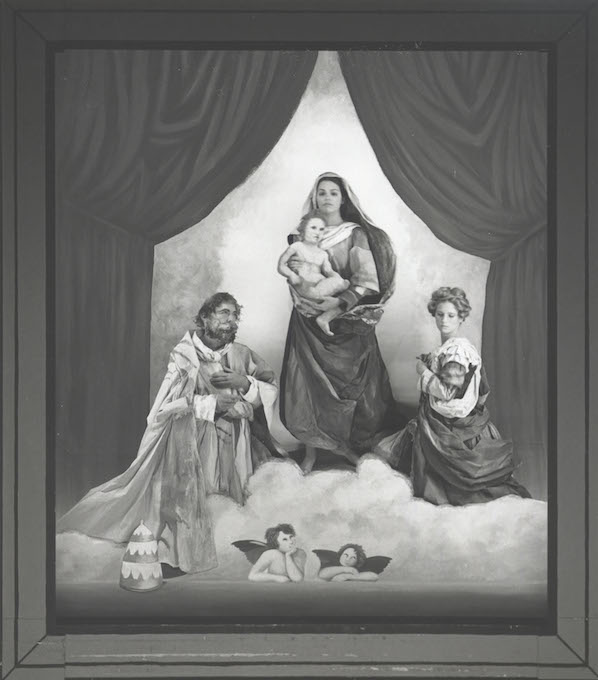
1933: Then called Spirit of the Masters Pageant, the first living pictures show took place in 1933 as a way to attract visitors to the second annual Festival of Arts, which charged a 10-cent admission fee. The Pageant kicked off with a parade of costumed characters—“Whistler’s Mother,” “The Blue Boy,” “Mona Lisa,” “Sistine Madonna” and Atlas—filing their way down Coast Highway from the Laguna Beach Art Association’s art gallery (the predecessor to Laguna Art Museum) to El Paseo Street, where the festival tent was located near Hotel Laguna.
At 6:30 p.m. each night, from Aug. 28 to Sept. 4, 1933, the pageant was presented (without painted backdrops or lighting) inside a rolling wagon stage that was about the size of two phone booths. The first tableau was a re-creation of Louis Betts’ “The Girl of the Golden West,” portrayed by Josie Derkum Rice, who had been the original model for Betts’ painting 18 years earlier.
1935: It wasn’t until this year that Roy Ropp—who would become known as the Father of the Pageant—stepped in as director and renamed the show Pageant of the Masters. With the help of his wife, Marie, he added painted backdrops, music and narration as well as a bigger stage at the new location at Heisler Point next to the LBAA art gallery. Roy constructed and painted the backdrops on the couple’s patio while Marie organized the costumes, selected music—performed by a local group called the Beaux Arts Trio—to accompany each piece, researched the artwork and wrote a script to be read during the show, which lasted 45 minutes.
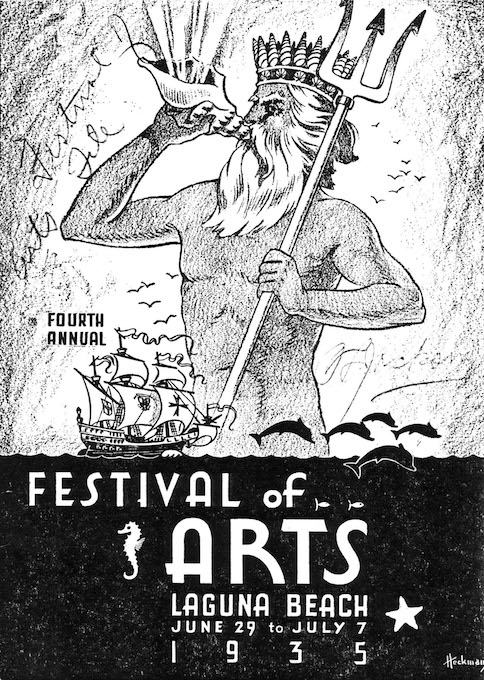
1935: Back in the day, the Pageant was a full celebration of the arts complete with activities throughout the city including studio tours, tea with artists and, in 1935, a pirate show to entertain the kids. Over the years, the Pageant show itself has featured a variety of additions beyond re-creations of paintings and sculptures, from a live horse to a working automobile, dance troupes and more.
1936: The second year under Roy Ropp’s direction, “The Last Supper” by Leonardo da Vinci premiered at the Pageant. This piece de resistance has become a tradition—ending every show since then, except for two years when other artists’ renditions of the scene were re-created instead. But that first year’s triumph came with plenty of challenges along the way. More than twice the size of the other presentations, with 13 cast members seated behind a table, the stage had to be expanded. And finding the right person to portray Jesus proved difficult. Finally, a woman—Jackie Martin, a Festival of Arts board member—took the role, but it was kept a tightly guarded secret. As Ropp reportedly said later, “Mrs. Martin had been blessed with a strong, noble face, excellent forehead, nose and eyes. Like a flash, I had seen the qualities I had been seeking.”
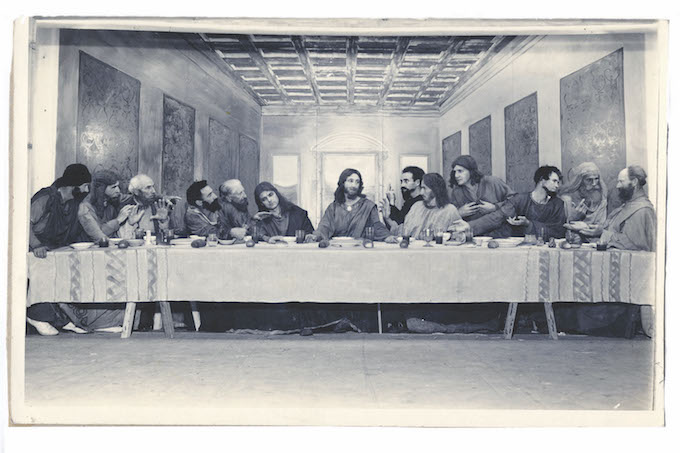
1936: Ropp took another risk this year by introducing the Pageant’s first nude, a sculpture of Biblical figure Salome, who performed the Dance of the Seven Veils for her stepfather, King Herod Antipas. Salome was portrayed by Margo Sangster Goddard, who later recalled the uncomfortable experience. She disrobed next to the stage behind a makeshift screen, then white makeup was slathered all over her body to make her appear like a statue. Since there wasn’t much space between the stage and the audience back then, she later recalled that a group of kids squatted right in front of her and “guffawed noisily.” After that one performance, Goddard didn’t return to pose in the show until years later when production conditions improved.
1939: Pageant of the Masters was featured in the Tournament of Roses Parade that winds through Pasadena. That particular parade—the 50th annual edition, in fact—took place Jan. 2, as is the practice when New Year’s Day falls on a Sunday. The Pageant float was a depiction of “The Last Supper” created out of flowers and other plant material.
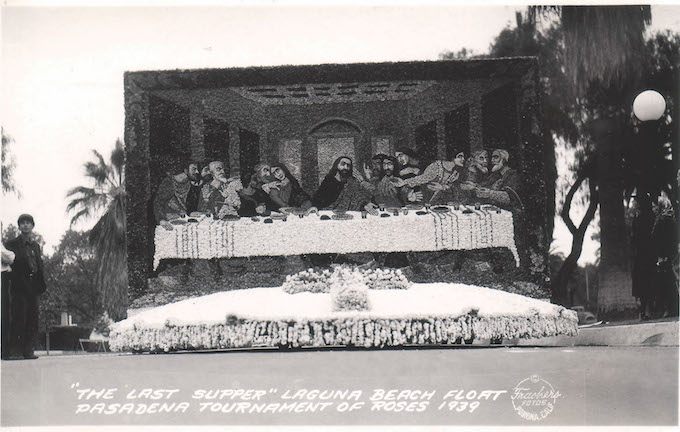
1941: Pageant of the Masters dedicated its permanent new home on nearly 6 acres in the Irvine Bowl. The land was partly owned by the Irvine family with the rest serving as a dairy farm before the Pageant took over. The stage constructed there was later torn down in 1956 and a new cement block stage (still used today) was built in its place at a cost of $110,000.
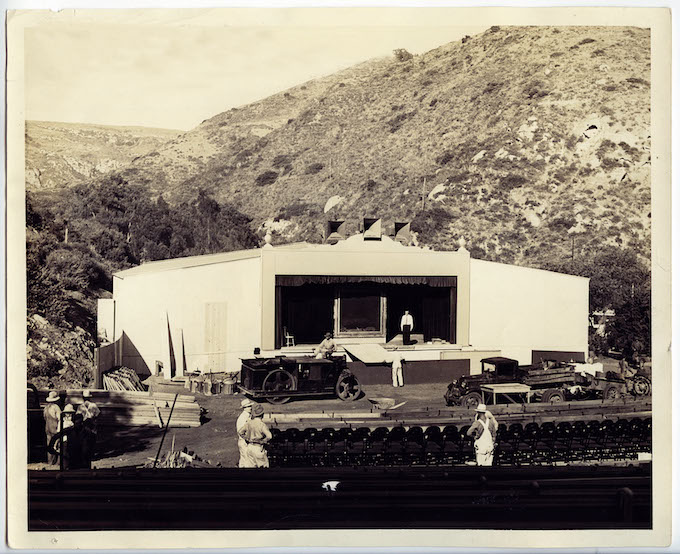
1941: Famous painter Norman Rockwell was among those in the crowd to see a portrayal of his painting “Hollywood Dreams.” In meeting the cast afterward, Rockwell reportedly said it was the “best I have ever seen—better than the photo engravings.” Over the years, several artists have attended the Pageant to see their artworks re-created on stage. This year, Wayne Alaniz Healy of Los Angeles is expected to attend as his 2001 oil painting “Pre-Game Warm Up” is slated for the show’s second half.
Later, in 1955, nudity proved controversial when the Pageant’s 1954 rendition of the ancient Greek sculpture Venus de Milo appeared on the cover of a California visitors guide. The photo was deemed “lewd and lascivious” by a Pan American Airways representative, who condemned the guide from being handed out to passengers on their flights. However, the Pageant has continued a longstanding tradition of presenting re-created paintings, sculptures and the like with nude subjects. Previously the only paid position, those portraying a nude subject now are volunteers who wear a skintight bodysuit that’s painted to show the brush strokes.
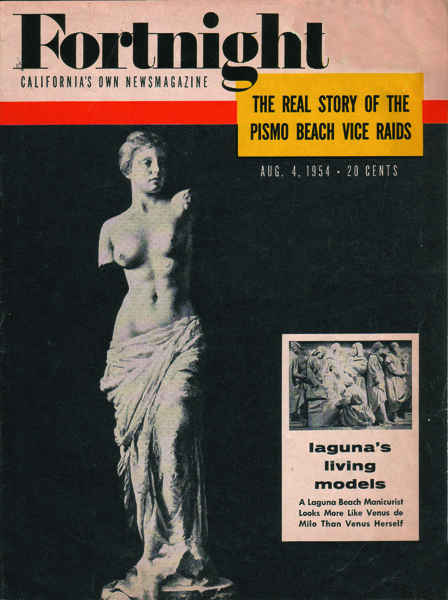
1957: Actress Bette Davis, who owned a home in Laguna and often attended the Pageant, helped out from time to time. In 1957, at the request of then-Director Howard “Hap” Graham and armed with a cup of white paint and a brush, Davis repainted the numbers on the venue’s seats. She was also supposed to appear on stage in “The Tragic Muse” by Sir Joshua Reynolds, but ended up taking a bad fall and broke a vertebra so she never actually took to the stage to play the role—although many likely thought she did as Davis graced that year’s souvenir program in a photo of the piece’s dress rehearsal.
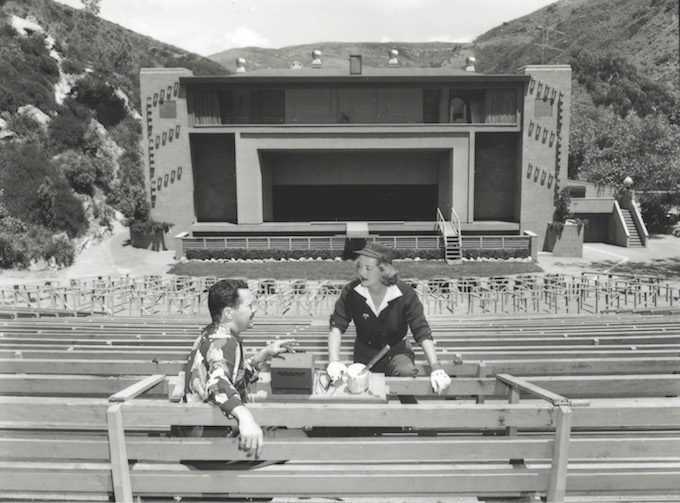
1969: Although a photo could not be found of this memorable moment, many recall the show when a pigeon landed on one of the living statues. It all started on the roof of the stage house, where bronze bell ringers banged their mallets against a bell (made to look like the one atop St. Mark’s Basilica Clock Tower in Venice, Italy). At the same time, trained homing pigeons were released into the air. They would typically circle a few times then return home to perform again the next night. But this time, one of the birds became disoriented and continued to circle as the show went on. The fourth presentation was a white earthenware sculpture of Pygmalion and Galatea by Etienne-Maurice Falconet. It was during this scene that the pigeon decided to land on the shoulder of Galatea, portrayed by Cathe Mennen, who was covered in sticky white makeup for the role. The pigeon couldn’t hold on and started sliding down Mennen’s chest, all the way to her thigh, then reportedåly pecked and clawed its way back up, leaving her scratched and bleeding. But, Mennen didn’t move a muscle, holding her pose for the duration of the scene—and receiving a standing ovation for the feat.
1973: Another celebrity took part in the Pageant this year. Actor Vincent Price, known for his roles in horror films like “The Fly,” “The Last Man on Earth” and “The Masque of the Red Death,” was cast in a re-creation of “The Cardinal’s Portrait” painting by Toby Rosenthal, a fact that he later revealed before a national audience on the TV show “I’ve Got a Secret.”
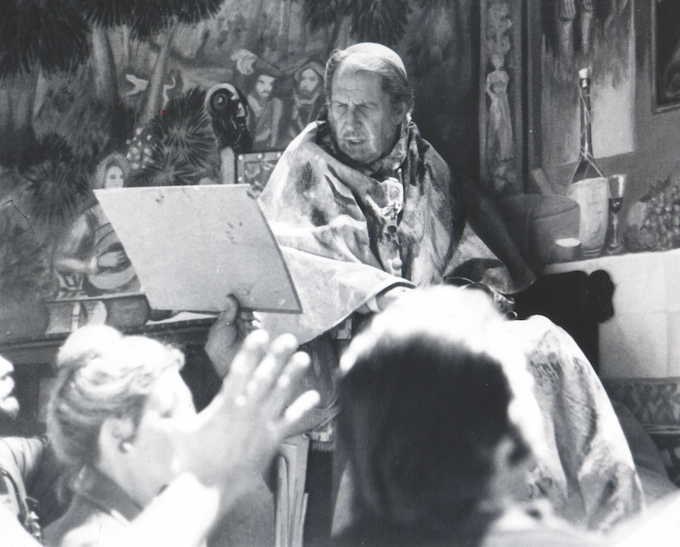
1974: The Pageant used to host a VIP night for celebrities with dinner and a reception at Hotel Laguna ahead of the show. In 1974, actress Betty White and her husband, TV personality Allen Ludden, were in attendance. Over the years, celebrities from actor Steve Martin to the late Lakers star Kobe Bryant have graced the Pageant’s audience. In 1999, the Pageant began presenting an annual benefit gala with celebrity hosts through the years ranging from Priscilla Presley, former wife of iconic signer Elvis Presley, to actresses Shirley Jones, Teri Hatcher and Jane Lynch, actors Neil Patrick Harris and Bryan Cranston, singer Paula Abdul, and Joe Mantegna of TV show “Criminal Minds.”
1974-1993: Dubbed “The Voice of the Pageant,” Hollywood veteran Thurl Ravenscroft served as the show’s narrator for nearly two decades, from 1974 to 1993. Ravenscroft, who later passed away in 2005, had an unmistakable voice. Perhaps best known for voicing Tony the Tiger, the Kellogg’s Frosted Flakes cereal mascot—remembered for saying “They’re grrreat!”—he also lent his booming, bass voice to Disneyland’s Haunted Mansion ride and he sang “You’re a Mean One, Mr. Grinch” in the TV special “How the Grinch Stole Christmas,” which first aired in 1966 on CBS.
1980s: Since the Pageant is set in an outdoor amphitheater nestled in Laguna Canyon, there are sure to be visitors of the wildlife persuasion. Bats can sometimes be seen flying overhead. No doubt squirrels have joined the audience from time to time. However, on one particularly memorable night in the 1980s, a skunk showed up on the conductor’s podium as then-Musical Director Richard Henn came out to begin the second act. Luckily, the animal didn’t spray, but scampered into a niche nearby. Of course, the show must go on, so Henn gave the downbeat to start the overture then alerted the director over his headphones. The skunk became increasingly agitated and, by the end of the overture, it had started hissing. So, they had to stop the show, with narrator Thurl Ravenscroft ad-libbing an announcement about this unexpected visitor—”a little gentleman in black in white”—who had taken up residence in the orchestra pit. Security helped to coax and nudge the skunk out of the pit and Henn later recalled seeing the creature “hightailing it out of the canyon.” Luckily, the animal never sprayed and the crowd avoided what could have been a stinky situation.
1993: Along with much of Laguna Canyon, the Pageant’s home at Irvine Bowl and the Festival of Arts grounds suffered $500,000 in damage from the infamous fire and flooding that year. Volunteers worked hard to save the property as flames crested over the surrounding hills in late October and then, two weeks later, from flooding as a rainstorm caused mudslides where the hills had so recently been scorched of their vegetation.
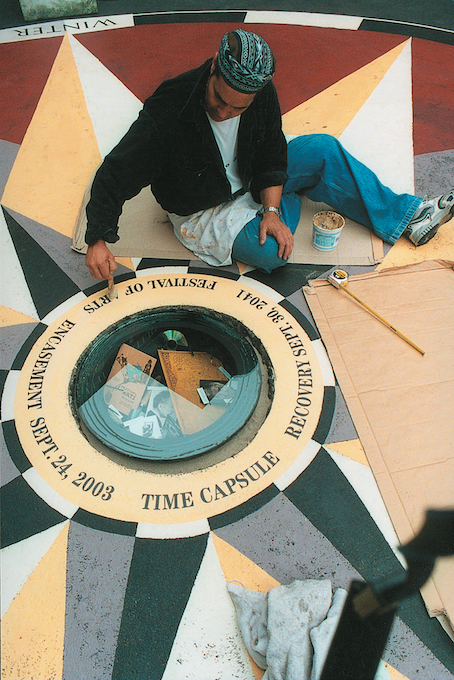
2003: On the occasion of the Pageant’s 70th anniversary, a time capsule was ceremonially “buried” at the Festival of Arts grounds—although the contents were later secured and safely stored off-site—to be opened Sept. 20, 2041 (based on the date that a long-term lease with the city for use of the property would expire). The time capsule included an archive of recorded interviews with longtime Pageant contributors and participants. Not only were DVDs filled with these interviews and full-color images of past souvenir programs among the buried treasure, but also paper transcripts and other historic materials as Director Diane Challis Davy realized even back then that DVDs would be antiquated and perhaps even unplayable by 2041.



